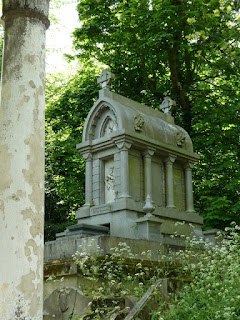Nunhead Cemetery, London
Visited May 2012
Nunhead Cemetery in Peckham Rye, south London is one of the seven original 'Magnificent Seven' Victorian garden cemeteries opened in London in the mid-19th century, and is quite possibly the least known of them, despite being the second largest. It was consecrated in 1840, originally known as All Saints Cemetery, Nunhead.
The Cemetery doesn't contain the great and the good of better known cemeteries such as Highgate or Kensal Green. It's now a local nature reserve, with large swathes of mature trees hiding a variety of angels and some quite magnificent mausoleums. The Anglican chapel was restored a few years ago, and stands like a Medieval ruin at the top of the main avenue. Burials are still carried out here, but only in family plots. The views over the City of London from the top of the hill are well worth the walk!








































